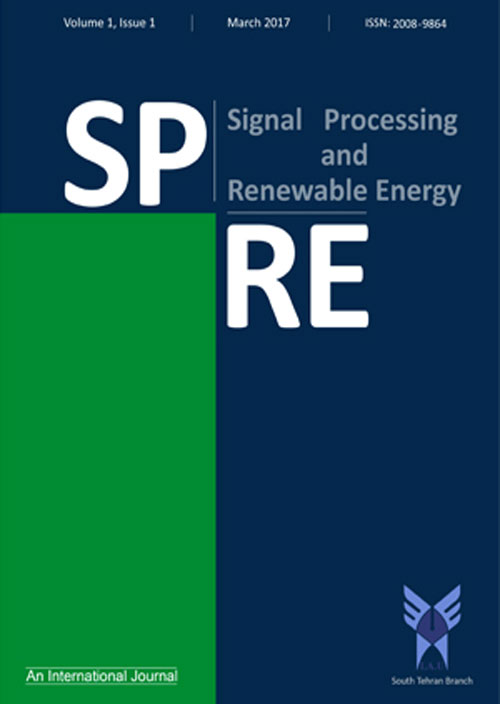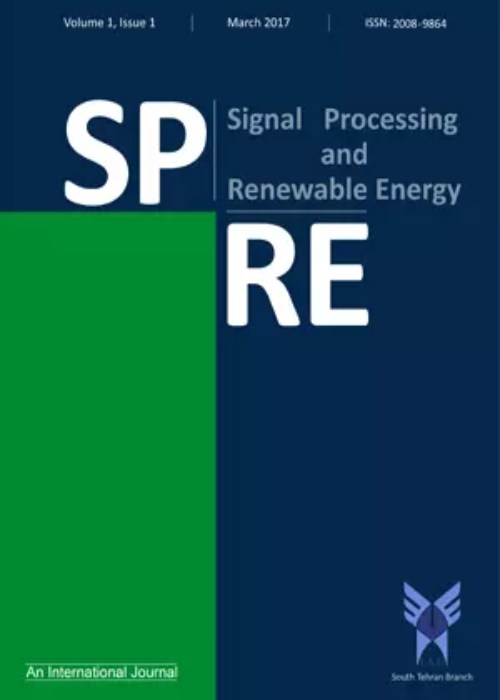فهرست مطالب

Signal Processing and Renewable Energy
Volume:6 Issue: 2, Spring 2022
- تاریخ انتشار: 1401/05/15
- تعداد عناوین: 6
-
Pages 1-15Since ECG signals are non-stationary physiological, the recorded signals are corrupted by varied noise resources. So, they cannot be used to diagnose the illness. Separating signals from undesired noise such as motion artifact, power-line interference (PLI), and baseline wander (BW), is the main problem when analyzing medical data. These destructive effects are more severe, especially during the patient's physical activity. The objective of this research is to find effective ways to remove anomalies in the cardiac signal. In this paper, a method for noise reduction has been presented. In this regard, the noise reduction from heart signal, is improved using an amalgamation adaptive and Savitsky-Golay filter. Also, the presented ANC is modified by combining with a SG filter as suggested ECG noise cancelation (A-S) system. Findings demonstrate that the suggested A-S is more accurate and adequate compared to the previous methods.Keywords: adaptive filter, Electrocardiogram, Noise Reduction, Savitzky-Golay filter (SG), Filter coefficient (Fc)
-
Pages 17-19In order to help people with disabilities, understanding presence of the coronavirus (covid-19) pandemic increasingly highlights the need for emerging technologies. As we know, brain computer interface (BCI) systems were hired to resolve the important challenges on the quality of life of people with disabilities and improve disabled person independent in performing daily activities. Therefore, in this work, BCI systems were furnished to study the type of movement of a person imagines from EEG signals. Before starting to analyze data, frequency bands and brain regions were first associated with motion imaging. Then, various types of spatial and frequency filters were applied to reduce signal noise, after that features were extracted by improving CSP algorithms like CSSP. Because the appropriate frequency band is not selected, the CSP results, which depend on frequency filtering, will not have the desired results, therefore CSSP method based on FIR filters is used. It means that we apply a frequency filter and frequency optimization occurred. The used data is standard data provided on bbci.de. In this database, 9 people have undergone EEG registration. Signal recording was performed in four visual classes including left-hand movement, right-hand movement, both feet, and language. To select the feature, we used the SFS feature algorithm. This algorithm achieved high accuracy by selecting six features together and using SVM classifier. In total, while the accuracy in the CSP method was 87.5%, in the CSSP method it reached 93.6 %.Keywords: Brain-Computer interface (BCI), EEG Signal Processing, CSP, CSSP, Feature extraction, classifier
-
Pages 31-45In this paper, a new adaptive controller based on barrier function is designed for high-order nonlinear systems with a sum of the uncertainty. Accordingly, in this paper, a sliding mode controller is used, which can create asymptotic convergence and at the same time can deal with disturbances. The main drawbacks of sliding mode control can be considered as asymptotic convergence, chattering phenomenon, stimulus saturation, adaptive gain estimation and failure to deal with oscillating uncertainties. In this paper, the sliding mode control is used to deal with the phenomenon of asymptotic convergence and chattering and the barrier function is used to overcome the uncertainties of interest and fluctuation. The advantages of the proposed method include elimination of the chatting phenomenon, convergence in finite-time, compatibility with time-varying uncertainties, no use of estimation and no need for high information of disturbances. Stability analysis showed that under the proposed controller the tracking errors approach the convergence region close to zero and provide faster convergence. Finally, to prove the efficiency of the controller, based on hyperchaotic synchronization, we apply the proposed controller to the new 5D hyperchaotic system. The results showed that the proposed controller, despite the disturbances applied to the system, provides fast convergence and eliminates the chatting phenomenon.Keywords: adaptive controller based on barrier function, BFAFTSM control, chatting phenomenon, new 5D hyperchaotic system, hyperchaotic synchronization
-
Pages 47-65By increasing the use of different power electronic devices in the propulsion system and other applications in ships, the shipboard grid voltage may face issues, including dc-offset voltage, variations in voltage, and frequency. When a photovoltaic (PV) generation is utilized in a ship to provide auxiliary or emergency power to inject the current into the grid, the grid voltage needs to be accurately monitored to synchronize the injected current with the grid voltage. Phase-locked loops (PLLs) are responsible for extracting the phase, frequency, and amplitude of the grid voltage in the control unit of a grid-tied inverter. The proper and fast estimation of grid information under grid disturbances has a significant role in the system’s stability. In this paper, a phase-lock loop (PLL) algorithm based on a new frequency-lock loop (FLL) structure is proposed. The proposed PLL algorithm has a high-speed performance in estimating the phase, frequency, and amplitude of the grid voltage. Unlike conventional PLL-based FLLs, the phase shift variation in the proposed algorithm is not dependent on the frequency. Moreover, the proposed PLL algorithm doesn’t have the drawback of the input DC offset due to using DC offset rejection loop. The proposed approach has been simulated in MATLAB/Simulink environment. The simulation results for variations in voltage frequency, amplitude, and phase have been presented in the paper to confirm the validity of the proposed method.Keywords: phase locked loop, PV power, Shipboard power, SOGI
-
Pages 67-83Power system stabilizer (PSS) generates electrical torques by applying a signal to the excitation system, which reduces power oscillations. The PSS’s main function is to damp generator rotor oscillations. In this paper, the structure of a PSS based on PID controller for system stability enhancement is presented. The voltage regulator excitation system is equipped with IEEE type-DC1exciter model. The application of the controller is investigated by means of simulation studies on a single machine infinite bus power system. For the system without any PSS and the system with conventional PSS (CPSS) and proportional-integral-derivative PSS (PID-PSS), the system responses for three different conditions were obtained using equations linear simulation. Eigenvalue analysis is used for comparison. The simulation results show that the controller is effective in improving steady state and dynamic performances regardless of the system operating conditions.Keywords: Power System Stabilizer, single-machine infinite-bus (SMIB), PID Controller
-
Pages 85-94FACTS devices are installed in AC transmission networks to increase power transfer capability, stability, and controllability of the networks through series and/or shunt compensation. This paper shows a shunt flexible ac transmission system (FACTS) device used for voltage regulation in transmission lines. Phasor model of shunt FACTS devices is used. All the simulations for this work have been carried out using MATLAB/SIMULINK environment. Simulation results vali-date that power oscillation and voltage can be damped properly using of static var compensator (SVC) and static synchronous compensator (STATCOM).Keywords: FACTS devices, static synchronous compensator, static VAR compensator, Voltage Regulation


